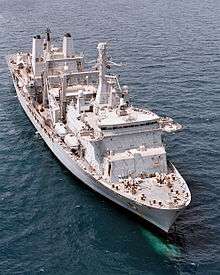Fort Victoria-class replenishment oiler
| Fort Victoria | |
| Class overview | |
|---|---|
| Name: | Fort Victoria class |
| Builders: |
|
| Operators: |
|
| Built: | 1988–1991 |
| In commission: | 1993– |
| Planned: | 6 |
| Completed: | 2: Fort Victoria, Fort George |
| Cancelled: | 4 |
| Active: | 1 |
| Laid up: | 0 |
| Retired: | 1 |
| Scrapped: | 1 |
| General characteristics | |
| Class and type: | Replenishment oiler |
| Displacement: | 32,300 long tons (32,818 t) full load |
| Length: | 203 m (666 ft 0 in) |
| Beam: | 30 m (98 ft 5 in) |
| Draught: | 10 m (32 ft 10 in) |
| Propulsion: | 2 shafts, Crossley-Pielstick V-16 diesels, 23,904 bhp (17,825 kW) |
| Speed: | 20 knots (23 mph; 37 km/h) |
| Complement: | 95 RFA / 15 RN / 154 FAA / 24 RNSTS civilians |
| Sensors and processing systems: |
|
| Electronic warfare & decoys: | |
| Armament: | 15 cell Sea Wolf VLS (fitted for but not with) |
| Aircraft carried: | Up to 5 × Sea King or Merlin helicopters (3 in hangar) |
The Fort Victoria or Fort II class is a class of replenishment oiler of the Royal Fleet Auxiliary, a role that combines the missions of a tanker and stores supply ship.[2] As such they are designated auxiliary oiler replenisher (AOR). They are tasked with providing ammunition, fuel, food and other supplies to Royal Navy vessels around the world. There are two ships in the class, Fort Victoria and Fort George, the latter being taken out of service and despatched for scrapping at a Turkish breakers as a consequence of budgetary cutbacks across the Royal Navy.
History

Six ships were initially planned to supply the Type 23 frigates in their North Atlantic anti-submarine role. The Type 23 was at the time planned to be a low cost, lightly armed vessel. The Fort class ships were therefore expected to defend both themselves and the Type 23 frigates with the Sea Wolf vertical launch surface-to-air missile (SAM).
The lessons of the Falklands War and the end of the Cold War led to a re-evaluation of this plan. The Type 23 emerged as a much more potent, multi-role vessel each carrying the Sea Wolf missile and the requirement for the Fort class was reduced from six to two.
Fort Victoria was built by Harland and Wolff and Fort George by Swan Hunter and the ships entered service in 1994 and 1993 respectively. Fort Victoria was delayed when she was bombed by the IRA on 6 September 1990 and nearly sunk.
Class Details
| Name | Pennant | Builder | Ordered | Laid down | Launched | Commissioned | Fate |
|---|---|---|---|---|---|---|---|
| Fort Victoria | A387 | Harland and Wolff, Belfast/Cammell Laird[3] | 23 April 1986[3] | 4 April 1988[3] | 12 June 1990[3] | 24 June 1994, under "assisted maintenance" at Rosyth Dockyard[3] | Active as of 2014 |
| Fort George | A388 | Swan Hunter, Wallsend-on-Tyne[3] | 18 December 1987[3] | 9 March 1989[3] | 1 March 1991[3] | 16 July 1993[3] | Decommissioned April 2011 Scrapped 2013 |
See also
- Fort Rosalie or Fort I class RFA replenishment ships
References
- Notes
- Bibliography
- Beaver, Paul, Britain's Modern Royal Navy, Patrick Stephens Limited, 1996, ISBN 1-85260-442-5
External links
Fort class replenshipment ships at the Royal Navy website